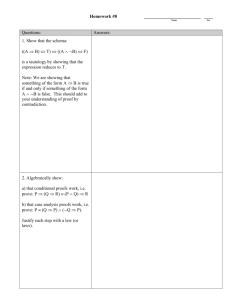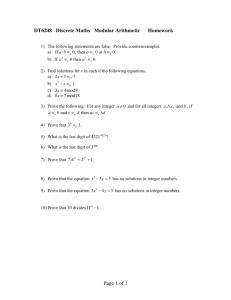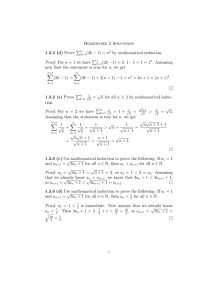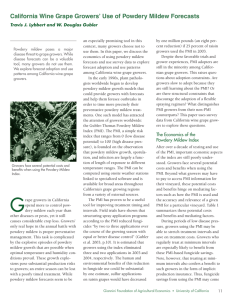Formal Methods Homework Assignment 9, Part 3
advertisement
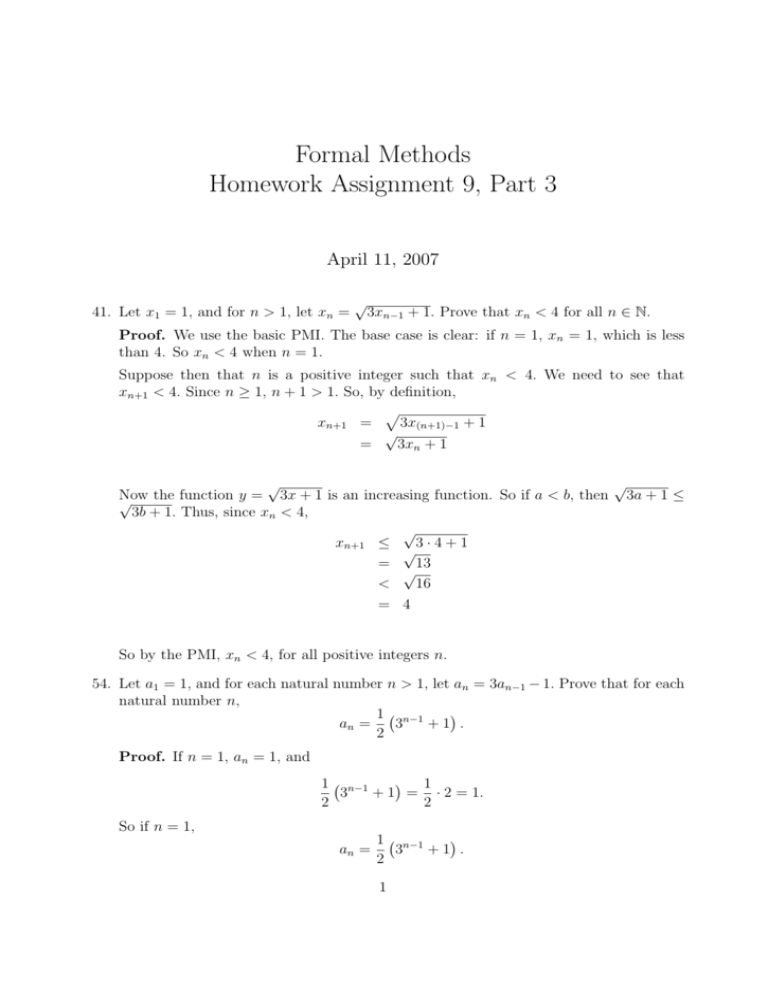
Formal Methods Homework Assignment 9, Part 3 April 11, 2007 41. Let x1 = 1, and for n > 1, let xn = √ 3xn−1 + 1. Prove that xn < 4 for all n ∈ N. Proof. We use the basic PMI. The base case is clear: if n = 1, xn = 1, which is less than 4. So xn < 4 when n = 1. Suppose then that n is a positive integer such that xn < 4. We need to see that xn+1 < 4. Since n ≥ 1, n + 1 > 1. So, by definition, p xn+1 = 3x(n+1)−1 + 1 √ 3xn + 1 = √ √ Now √ the function y = 3x + 1 is an increasing function. So if a < b, then 3a + 1 ≤ 3b + 1. Thus, since xn < 4, √ 3·4+1 xn+1 ≤ √ 13 = √ < 16 = 4 So by the PMI, xn < 4, for all positive integers n. 54. Let a1 = 1, and for each natural number n > 1, let an = 3an−1 − 1. Prove that for each natural number n, 1 n−1 an = 3 +1 . 2 Proof. If n = 1, an = 1, and 1 1 n−1 3 + 1 = · 2 = 1. 2 2 So if n = 1, an = 1 n−1 3 +1 . 2 1 Suppose then that n is a positive integer such that an = We need to show that an+1 = 1 n−1 3 +1 . 2 1 (n+1)−1 3 +1 . 2 Since n ≥ 1, n + 1 > 1. So an+1 = 3a(n+1)−1 − 1 = 3an − 1 1 n−1 3 +1 −1 = 3 2 3 1 = · 3 · 3n−1 + − 1 2 2 1 n 1 ·3 + = 2 2 1 (n+1)−1 = 3 +1 2 So by the PMI an = 1 n−1 3 +1 , 2 for all positive integers n. 55. Let a1 = 1 and a2 = 3, and for each natural number n > 2, let an = 3an−1 − 2an−2 . Prove that for each natural number n, an = 2n − 1. Proof. If n = 1, an = 1, and 2n − 1 = 2 − 1 = 1. So if n = 1, an = 2n − 1. [In the induction step, we would ordinarily assume that n is a positive integer such that an = 2n − 1, and then try to deduce that an+1 = 2n+1 − 1. However, this would involve cases, because there are two possible formulas for an+1 : the formula if n + 1 = 2 (i.e., n = 1) and the formula if n + 1 > 2. To avoid this we could prove that a2 = 22 − 1 directly, and then, in the induction step, instead of assuming n ≥ 1, we would assume n ≥ 2. Either approach is fine. I’ll use the second approach.] If n = 2, an = 3, and 2n − 1 = 22 − 1 = 3. So in this case also, an = 2n − 1. [Now if n ≥ 2, the formula for an+1 involves both an and an−1 . So instead of using the basic PMI, I’ll use the strong PMI.] Suppose then that n is an integer ≥ 2 such that ak = 2k + 1, whenever k = 1, 2, . . . , n. Then, since n ≥ 2, n + 1 > 2. So an+1 = 3a(n+1)−1 − 2a(n+1)−2 = 3an − 2an−1 = 3(2n − 1) − 2(2n−1 − 1) 2 = = = = 3 · 2n − 3 − 2 · 2n−1 + 2 3 · 2n − 2n − 1 2 · 2n − 1 2n+1 − 1 So by the strong PMI, for each positive integer n, an = 2n − 1. 57. Let a1 = a2 = a3 = 1, and for each natural number n > 3, let an = an−1 + an−2 + an−3 . Prove that for each natural number n > 1, an ≤ 2n−2 . Proof. By analogy with problem 55, we use the strong PMI and we prove three base cases. If n = 2, an = 1 and 2n−2 = 1. If n = 3, an = 1, and 2n−2 = 2. If n = 4, an = an−1 + an−2 + an−3 = a3 + a2 + a1 = 3, and 2n−2 = 4. So if n = 2, 3, or 4, an ≤ 2n−2 . Suppose then that n is an integer ≥ 4 such that ak ≤ 2k−2 for k = 2, 3, . . . n. We want to see that an+1 ≤ 2(n+1)−2 . Since n ≥ 4, n + 1 > 5. So an+1 = a(n+1)−1 + a(n+1)−2 + a(n+1)−3 = an + an−1 + an−2 Since n ≥ 4, n, n − 1, and n − 2 are all ≥ 2. So the induction hypothesis applies to an , an−1 , and an−2 , and an+1 = ≤ ≤ = = = = an + an−1 + an−2 2n−2 + 2n−3 + 2n−4 2n−2 + 2n−3 + 2 · 2n−4 2n−2 + 2 · 2n−3 2n−2 + 2n−2 2 · 2n−2 2(n+1)−2 So by the strong PMI, an ≤ 2n−2 for all integers n ≥ 2. 3



